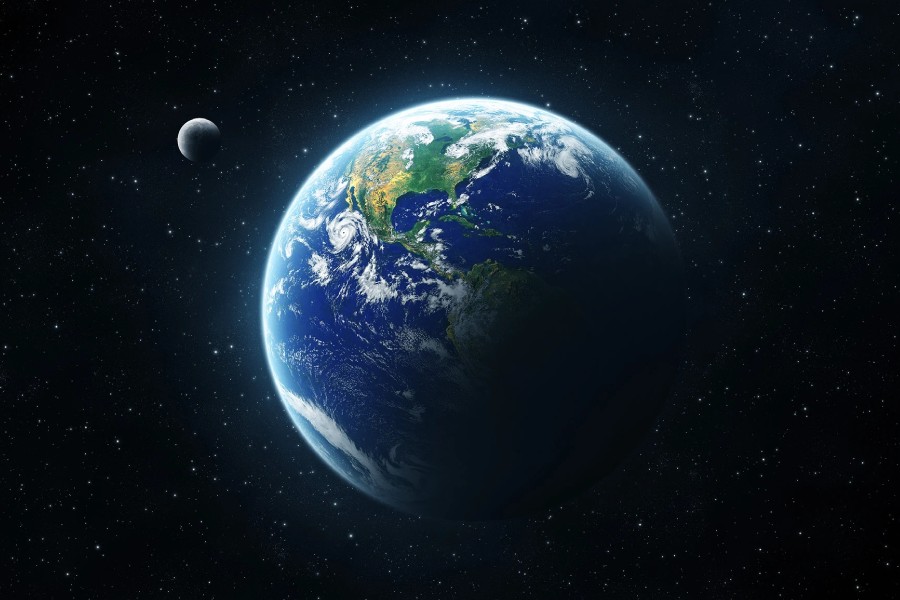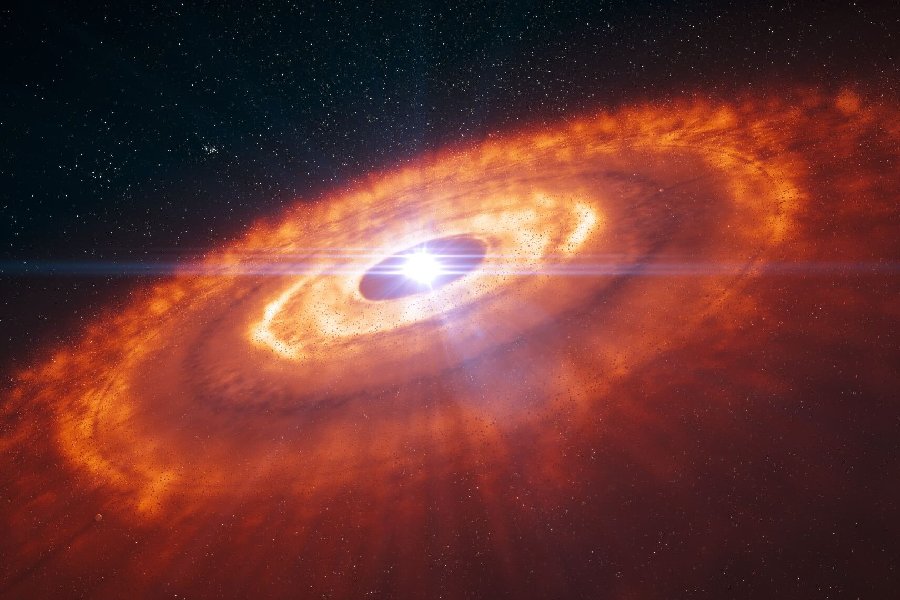Earth is like a lively blue ball full of life, spinning around a regular yellow star. It has a long and fascinating history that led to how it looks today. So, ever wondered how the Earth was made?
The story of Earth’s creation took billions of years and involves big events in space, like old stars dying and planets crashing into each other. To understand exactly how Earth was made, scientists look for clues. In this article, we’ll go back over four billion years to uncover the step-by-step events that brought our cozy planet into existence.
How the Earth Was Made?
The Earth formed over 4.5 billion years ago from a solar nebula – a cloud of gas and dust that created the Sun and Solar System. These grew into Mars-sized protoplanets.
About 50 million years after the Solar System began forming, one protoplanet called Theia impacted early Earth. This giant collision melted and reformed Earth while throwing debris into orbit that later coalesced through gravity into the Moon.
Accretion and the collision left a molten Earth that gradually cooled, allowing lighter compounds to rise and form the early oceans and atmosphere. Within a couple hundred million years, Earth had become a rocky planet with liquid water on its surface – ready for the emergence of life.

Earth’s Origin Story: The Background
Background on core accretion theory
The concept of core accretion theory traces back to the early 20th century. It emerged as a pivotal explanation for the formation of planets. In the cosmological context, it addresses the question of how celestial bodies like Earth took shape amid the vastness of the universe.
Initially proposed by Otto Schmidt in 1944 and later refined by Viktor Safronov in the 1960s, core accretion theory gained momentum as astronomers sought a comprehensive model to elucidate the intricate process of planetary formation. It’s now a crucial part of astrophysics, helping us figure out how planets, including Earth, developed over time.
Core Accretion Theory Basis
Nebular hypothesis foundation
Core accretion is closely tied to how our solar system formed, known as the nebular hypothesis. This theory suggests that a spinning cloud of gas and dust from space collapsed to create the Sun and the planets. Our planetary system began to develop as this cloud got smaller due to gravity.
Inside this cosmic cloud, tiny dust particles stuck together over time through accretion. They formed bigger and bigger clumps, turning into asteroid-sized objects called planetesimals. These planetesimals then joined forces to become larger protoplanets, eventually evolving into the planets we see in our solar system today.
Accretion mechanism
Inside the swirling cloud of gas and dust around the young Sun, specks of dust started sticking together over time. They formed larger groups through a process called accretion.
So, these groups got bigger and became planetesimals, like small asteroids. Eventually, these planetesimals joined forces, creating protoplanets the size of Mars, becoming the planets we see today.
As mentioned, scientists use the core accretion theory to explain how Earth came to be. According to this theory, Earth’s journey began with dust coming together to make planetesimals.
These planetesimals combined into larger bodies, ranging from the size of the Moon to Mars. Then, the growing bodies merged and changed to form the currently structured planets. This theory aligns well with our observations at each step of the planets’ development.
Disk of Dust and Gas
Formation process
The first step in core accretion theory is when dust and gas come together to form a spinning disk. This happens because a big cloud of molecules collapses due to gravity. This collapse starts the disk spinning around the baby star in the middle.
As the cloud squeezes down, it keeps spinning because of something called angular momentum. This makes it flatten into a disk around the young star. The forces that make things go in a circle, like centripetal acceleration and gravity, balance out. So, the disk ends up stable, with most of the stuff near the middle going around the baby star.
Role in planet formation
Small particles collide and aggregate within this disk, forming larger bodies called planetesimals. These planetesimals are the building blocks for the eventual formation of planets, including Earth. The disk provides a dynamic environment for these celestial bodies to take shape.
Furthermore, dust grains overcome electrostatic barriers, allowing accretion into centimeter-to-meter-sized particles. These combine into multi-miles planetesimals, merging into Moon-to-Mars-sized protoplanetary embryos that develop into planets through differentiation.

Protoplanetary Disk Details
Disk structure
The spinning disk of gas and dust around a young star has different parts where planets can form. Close to the center, it makes rocky planets. Farther out, it creates big gas giants.
Additionally, the disk has hot and cold zones. The hot inside likes making solid rocky planets. The cooler outer parts let icy objects and big frozen gas planets form. And there are different amounts of elements in the disk.
Lifetime and dispersal
Protoplanetary disks hang around for about 1 to 10 million years before they either come together, shrink, or spread out due to stellar winds, jets, and nearby supernovae. Many of the disk stuff join the central star or form planets. What’s left behind becomes asteroids, comets, and space dust.
When we observe them, we see these protoplanetary disks getting smaller and breaking apart as time passes. The disk breaking up limits how long it takes for big planets to form. Most of the stuff in the disks makes stars or planets, but some get sent flying across star systems as cosmic dust.
Observational Evidence
Using advanced telescopes to study young star systems has confirmed the existence of protoplanetary disks as predicted by core accretion theory. These disks around young stars match what the models anticipated, strengthening the acceptance of this idea in astrophysics.
Telescopes like ALMA are powerful tools that allow scientists to see protoplanetary disks in different star systems directly. They reveal details about the disks, such as gaps, rings, asymmetries, and grain growth, providing evidence of favorable conditions for planet formation. These disks can be observed around stars aged 1-10 million years.
Analyzing disk composition
Scientists can figure out what stuff is there by using special tools to look at the light from disks around stars. They can see signs of small particles getting bigger and find water concentrations and basic organic stuff. This helps them find places where asteroids, planets, and other things can form, as core accretion explains.
Moreover, scientists can see tiny dust sticking together to make bigger bits when looking at the different kinds of light from young planetary systems. They also find many heavy elements and basic organic materials that create planets like Earth. These findings support the steps in core accretion for how solar systems like ours come together.
Verifying theoretical models
As telescope observations advance, protoplanetary disks closely match structures and compositions predicted by astrophysical models. Finding these pivotal disk stages in young star systems verifies core accretion’s picture of the planet formation sequence around nascent stars across the galaxy.
The disks we see now align with what core accretion predicted years ago. Understanding how these disks work is important because they play a big part in making planets. By studying the dynamics of these disks, we can trace back how Earth and other planets formed from the first gravitational changes in a cloud of molecules.
Conclusion
Unraveling the intricate sequence of events behind how the Earth was made has captivated astronomers seeking to explain our planet’s origins. Leading models describe this as a multi-billion-year process, from initial cloud collapse to the accretion of cosmic material into terrestrial worlds.
As we explored, the prevailing core accretion framework traces step-by-step how cosmic dust and gas coalesced over time into planets. Advances in astronomical observations and simulations of emerging solar systems support this well-established theory.
Though many details are still being uncovered, the advancing capabilities of astronomy continue to reinforce our understanding. They also extend our understanding of Earth’s genesis over four billion years ago among the stars.
